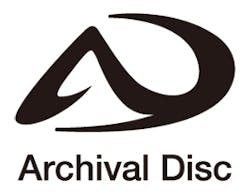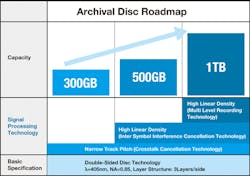A new generation of high-capacity optical discs is coming, and it marks an important change in direction for an application that has accounted for a large portion of all the lasers in existence. Sony (Tokyo, Japan) and Panasonic (Osaka, Japan) have developed a standard for an "Archival Disc" for archival data storage (see http://www.sony.net/SonyInfo/News/Press/201403/14-0310E/index.html). They are starting with a 300 Gbyte format, and have a roadmap for expanding disc capacity to 1000 Gbytes.
Both the choice of market and the choice of technology show changes in trends that date back more than three decades.
The audio Compact Disc was a brilliant success in digitizing music and distributing it to consumers. Based on a 780 nm diode laser, it packed over 600 Mbytes onto a 12 cm disk—an impressive capacity when the CD was introduced in 1982. The CD-ROM data format followed—first mass-produced for software and data distribution, then writable for consumer recording of voice and data.
The DVD followed in 1995 for digital video distribution, based on a 650 nm red diode laser and recording 4.7 Gbytes on the initial single-layer, single-side format. Blu-ray, based on a 405 nm violet diode laser, followed in 2006, targeted at HD video distribution. But Blu-ray is losing ground to streaming video in the marketplace. Market pundits are claiming optical discs are dead, although broadband capacity remains an issue for streaming HD in many areas. So developers are aiming their next generation of optical discs at long-term data storage for large archives or backup systems, some of which still rely on magnetic tape. Their release does not identify project lifetime.
More interesting from an optical viewpoint is the choice of laser—the now well-established 405 nm violet diode. That reflects the same scarcity of good shorter-wavelength sources that has kept the 193 nm argon-fluoride laser as the backbone of semiconductor photolithography. Diode lasers emitting 375 nm are available, but they don't decrease spot size enough to make the change worthwhile.
Like photolithography developers, the Archival Disc will rely on optics to write smaller spots. The optics will have a high numerical aperture of 0.85, and write on three layers per side of a double-sided disc to fit 300 Gbytes. The track pitch will be 225 nm, just over half a wavelength, and data bits will be 79.5 nm, less than one-fifth of a wavelength. Bit spacing will be even tighter for 500 and 1000 Gbyte discs. Demonstrating that the discs can meet those specifications on the time scales sought for archives will pose an interesting challenge.



